Online Evaluation for the Accuracy of Electronic Voltage Transformer Based on Recursive Principal Components Analysis
Abstract
1. Introduction
2. Correlation Analysis
- Periodic error: for instance, the error of the EVT with a capacitive or resistive voltage divider, which changes because of the temperature-dependent characteristics of the capacitive and resistive components.
- Inherent error: for example, after a broken or damaged capacitive element of the EVT, a significant ramp in the ratio error is taking place.
- Other error: some parts of the EVT may undergo electrical and thermal aging, leading to inevitable error.
3. Online Evaluation Using RPCA
3.1. Tradition PCA
3.2. Recursive Principal Components Analysis
3.3. Evaluation Indicator
4. Experimental Analysis
4.1. Design of Experiment
- Offline learning by PCA:
- Obtain normal operation data; Calculate mean and covariance matrix ;
- Calculate the Q-statistic and its control limit .
- Online learning by RPCA:
- Recursively renew the mean , covariance matrix and principal component model of PCA;
- Recursively update Q-statistic and its control limit ;
- Determinate the abnormal phase of the EVT using the contribution rate method.
4.2. Fault Simulation
4.3. Online Evaluation Results
5. Conclusions
Author Contributions
Funding
Conflicts of Interest
References
- Wu, W.; Xu, Y.; Xiao, X.; Hu, H. Research on proximity effect in measuring error of active electronic voltage transformers. IEEE Trans. Instrum. Meas. 2016, 65, 78–87. [Google Scholar] [CrossRef]
- Li, Z.; Xiang, X.; Hu, T.; Abu-Siada, A.; Li, Z.; Xu, Y. An improved digital integral algorithm to enhance the measurement accuracy of Rogowski coil-based electronic transformers. Int. J. Electr. Power Energy Syst. 2020, 188, 105806. [Google Scholar] [CrossRef]
- Zhu, B.; Ding, F.; Vilathgamuwa, D.M. Coat circuits for DC-DC converters to improve Voltage conversion ratio. IEEE Trans. Power Electron. 2019, 35, 3679–3687. [Google Scholar] [CrossRef]
- Chen, K.; Wan, R.; Guo, Y.; Chen, N.; Lee, W. A redundancy mechanism design for Hall-based electronic current transformers. Energies 2017, 10, 312. [Google Scholar] [CrossRef]
- Liu, H.; Wang, K.; Yang, Q.; Yin, L.; Huang, J. On-Line Detection of Voltage Transformer Insulation Defects Using the Low-Frequency Oscillation Amplitude and Duration of a Zero Sequence Voltage. Energies 2019, 12, 619. [Google Scholar] [CrossRef]
- Ruan, S.; Wang, D.; Xu, K.; Xu, H.; Li, F.; Lü, P. ECT Fault Statistical Analysis of DC Transmission System. Power Syst. Technol. 2018, 42, 3170–3175. [Google Scholar]
- Li, Z.; Jiang, W.; Abu-Siada, A.; Li, Z.; Xu, Y.; Liu, S. Research on a composite voltage and current measurement device for HVDC networks. IEEE Trans. Ind. Electron. 2020. [Google Scholar] [CrossRef]
- Liu, Y.; Yang, N.; Dong, B.; Wu, L.; Yan, J.; Shen, X.; Xing, C.; Liu, S.; Huang, Y. Multi-lateral Participants Decision-making: A Distribution System Planning Approach with Incomplete Information Game. IEEE Access 2020. [Google Scholar] [CrossRef]
- Li, Q.; Lu, S.; Yang, S.; Li, H.; Li, D. Comparsion of two electronic transformer error measuring methods. High Volt. Eng. 2011, 37, 3022–3027. [Google Scholar]
- Djokic, B.; So, E. Calibration system for electronic instrument transformers with digital output. IEEE Trans. Instrum. Meas. 2005, 54, 479–482. [Google Scholar] [CrossRef]
- Li, Z.; Li, H.; Zhang, Z.; Luo, P. An Online Calibration Method for Electronic Voltage Transformers Based on IEC 61850-9-2. MAPAN J. Metrol. Soc. India 2014, 29, 97–105. [Google Scholar] [CrossRef]
- Hu, C.; Chen, M.; Li, H.; Zhang, Z.; Jiao, Y.; Shao, H. An accurate on-site calibration system for electronic voltage transformers using a standard capacitor. Meas. Sci. Technol. 2018, 29, 055901. [Google Scholar] [CrossRef]
- Xiong, X.; He, N.; Yu, J.; Chen, X.; Zi, M.; Hu, Z. Diagnosis of Abrupt-Changing Fault of Electronic Instrument Transformer in Digital Substation Based on Wavelet Transform. Power Syst. Technol. 2010, 34, 181–185. [Google Scholar]
- Jiang, Y.; Wang, J.; Li, J.; Yu, W.; Chen, B. Application of Artificial Neural Network to Fault Diagnosis for Optical Voltage Transformer. Proc. CSU-EPSA 2018, 30, 134–139. [Google Scholar]
- Lei, T.; Faifer, M.; Ottoboni, R.; Toscani, S. On-line fault detection technique for voltage transformers. Measurement 2017, 108, 193–200. [Google Scholar] [CrossRef]
- Liu, J.; Pei, J.; Tian, M.; Zhu, X. Research on nonlinear correction method of current transformer based on support vector machine. Electr. Mach. Control. 2020, 24, 130–138. [Google Scholar]
- Reza, M.S.; Sadeque, F.; Hossain, M.M.; Ghias, A.M.Y.M.; Agelidis, V.G. Three-Phase PLL for Grid-Connected Power Converters under Both Amplitude and Phase Unbalanced Conditions. IEEE Trans. Ind. Electron. 2019, 66, 8881–8891. [Google Scholar] [CrossRef]
- Zhang, Z.; Li, H.; Tang, D.; Hu, D.; Hu, C.; Jiao, Y. Monitoring the metering performance of electronic voltage transformer on-line based on cyber-physics correlation analysis. Meas. Sci. Technol. 2017, 28, 105015. [Google Scholar] [CrossRef]
- Bianchi, F.M.; De Santis, E.; Rizzi, A.; Sadeghian, A. Short-Term Electric Load Forecasting Using Echo State Networks and PCA Decomposition. IEEE Access 2015, 3, 1931–1943. [Google Scholar] [CrossRef]
- Li, W.; Yue, H.; Valle-Cervantes, S.; Qin, S. Recursive PCA for adaptive process monitoring. J. Process Control 2000, 10, 471–486. [Google Scholar] [CrossRef]
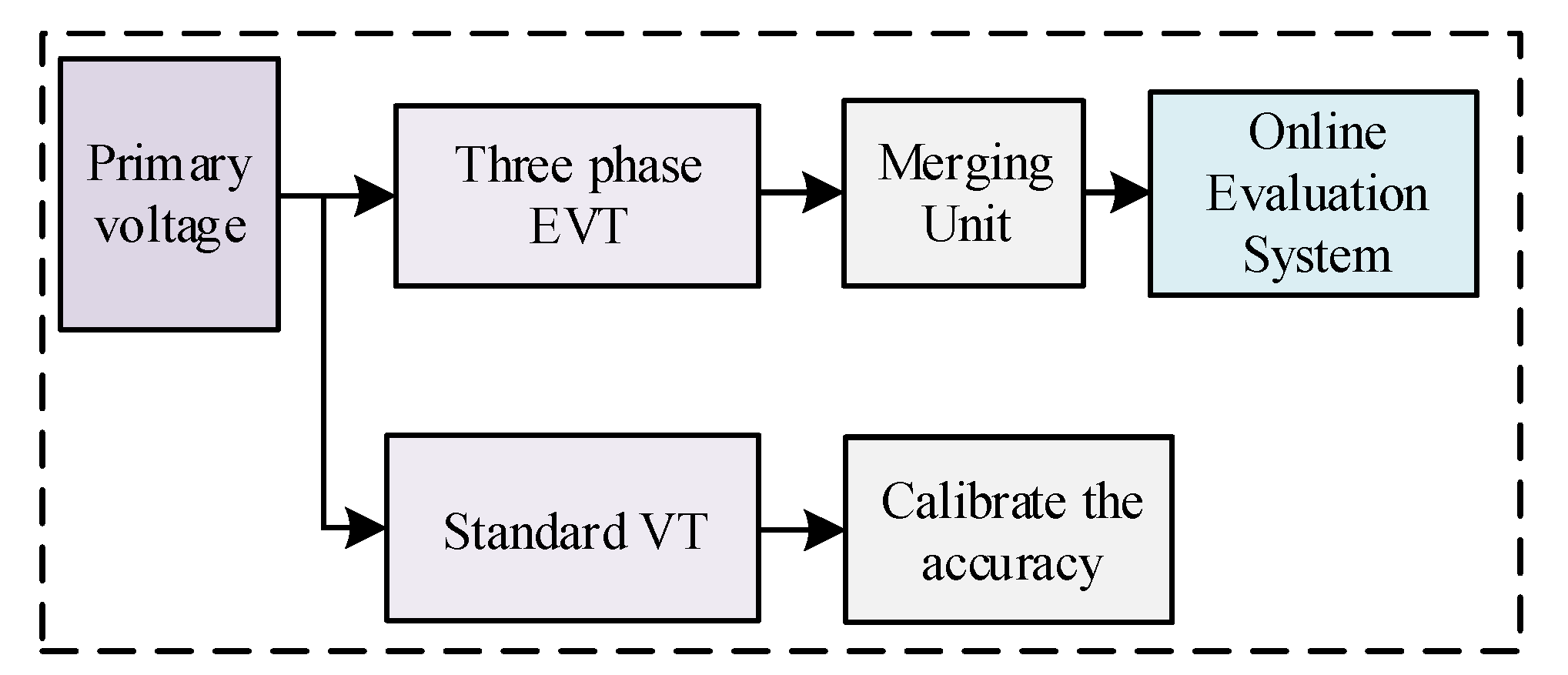


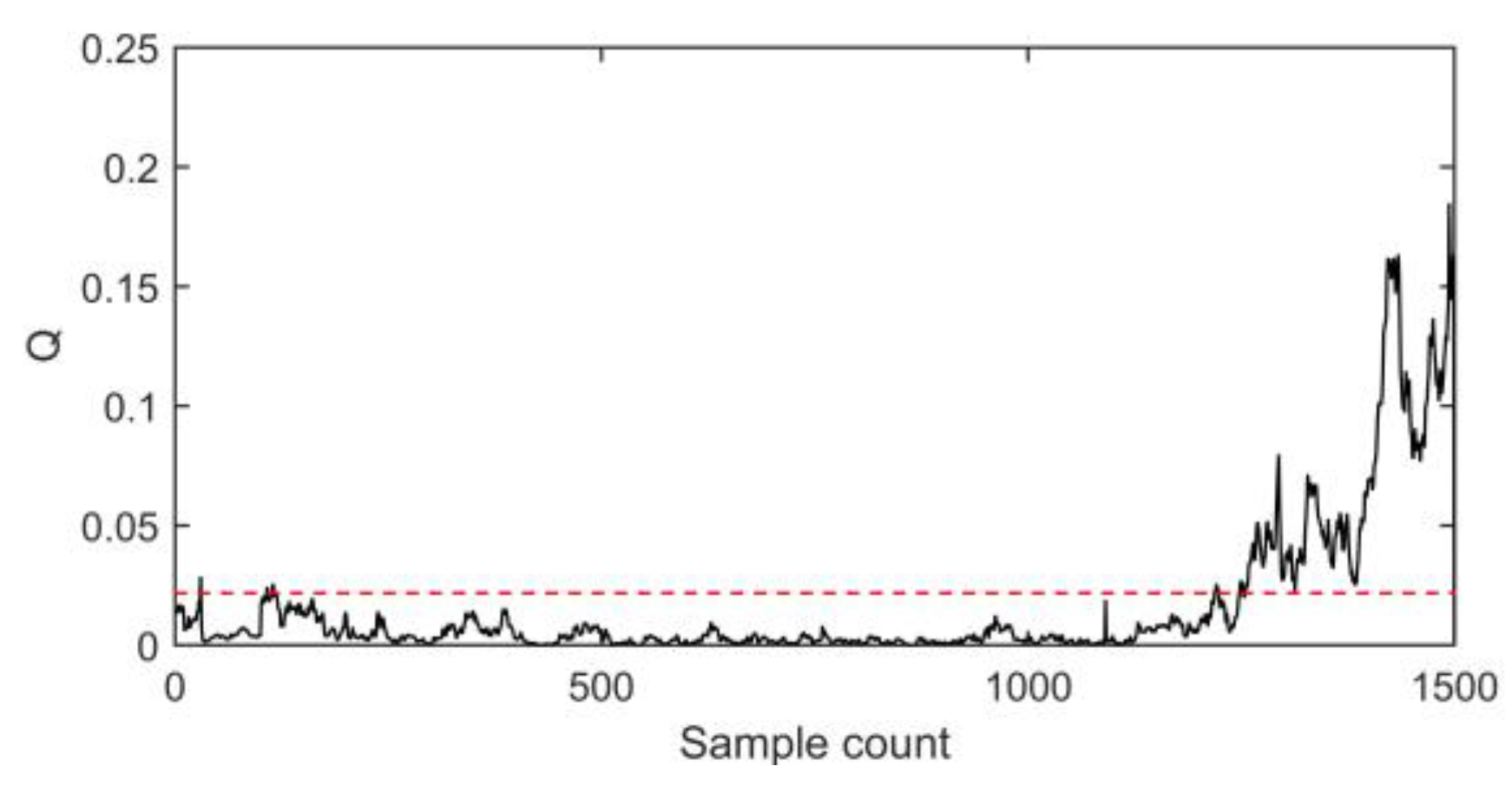
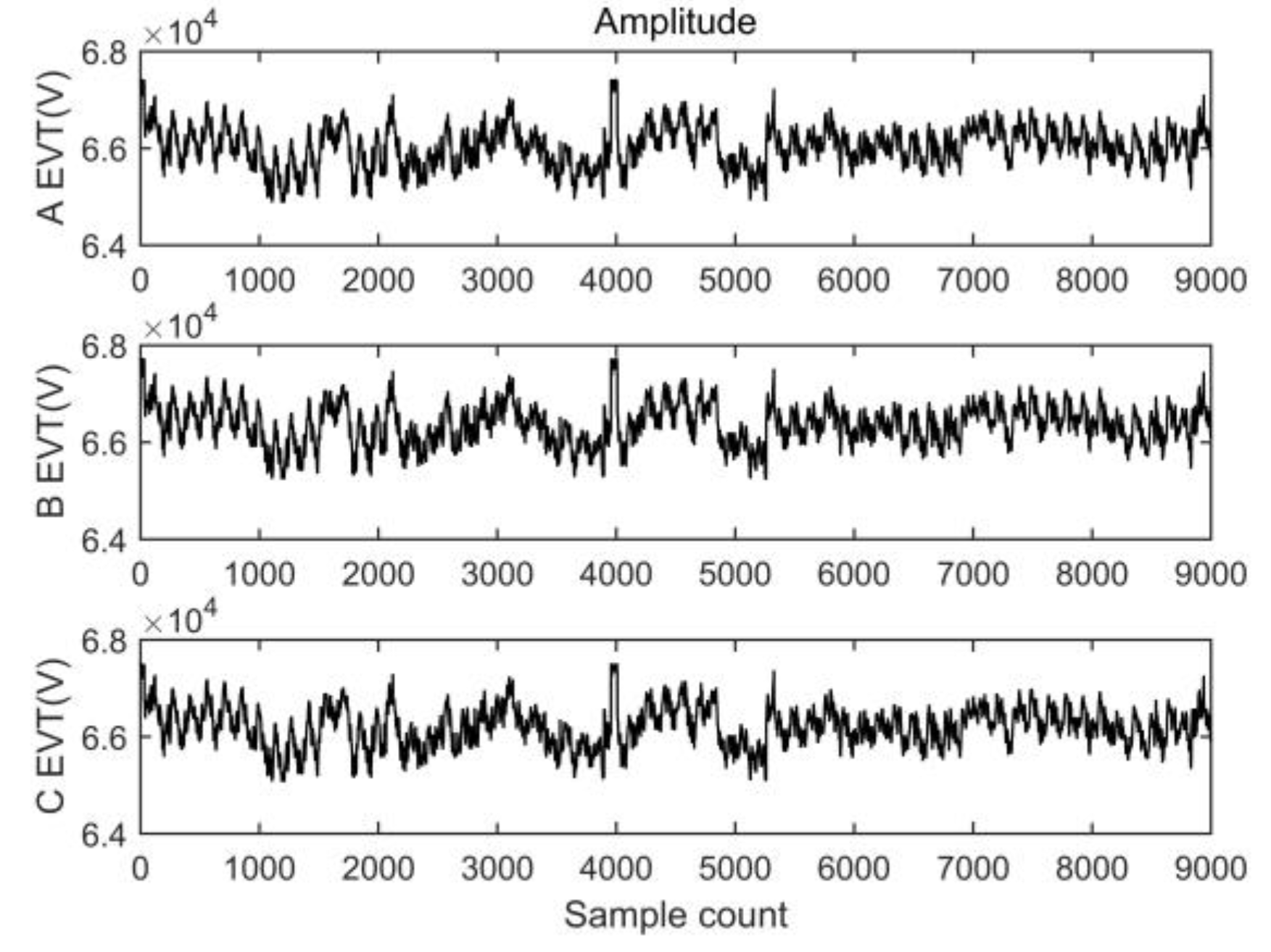

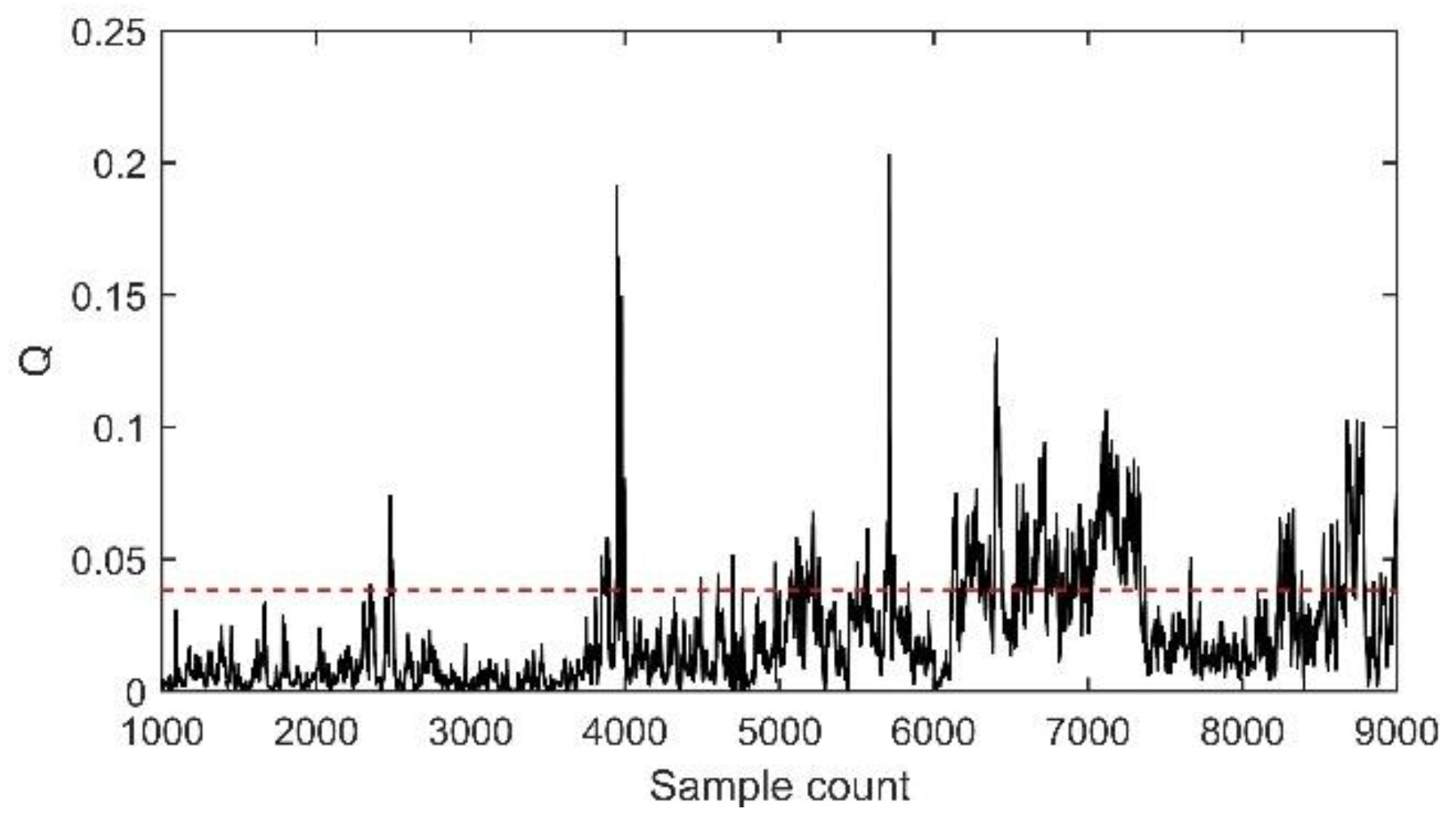
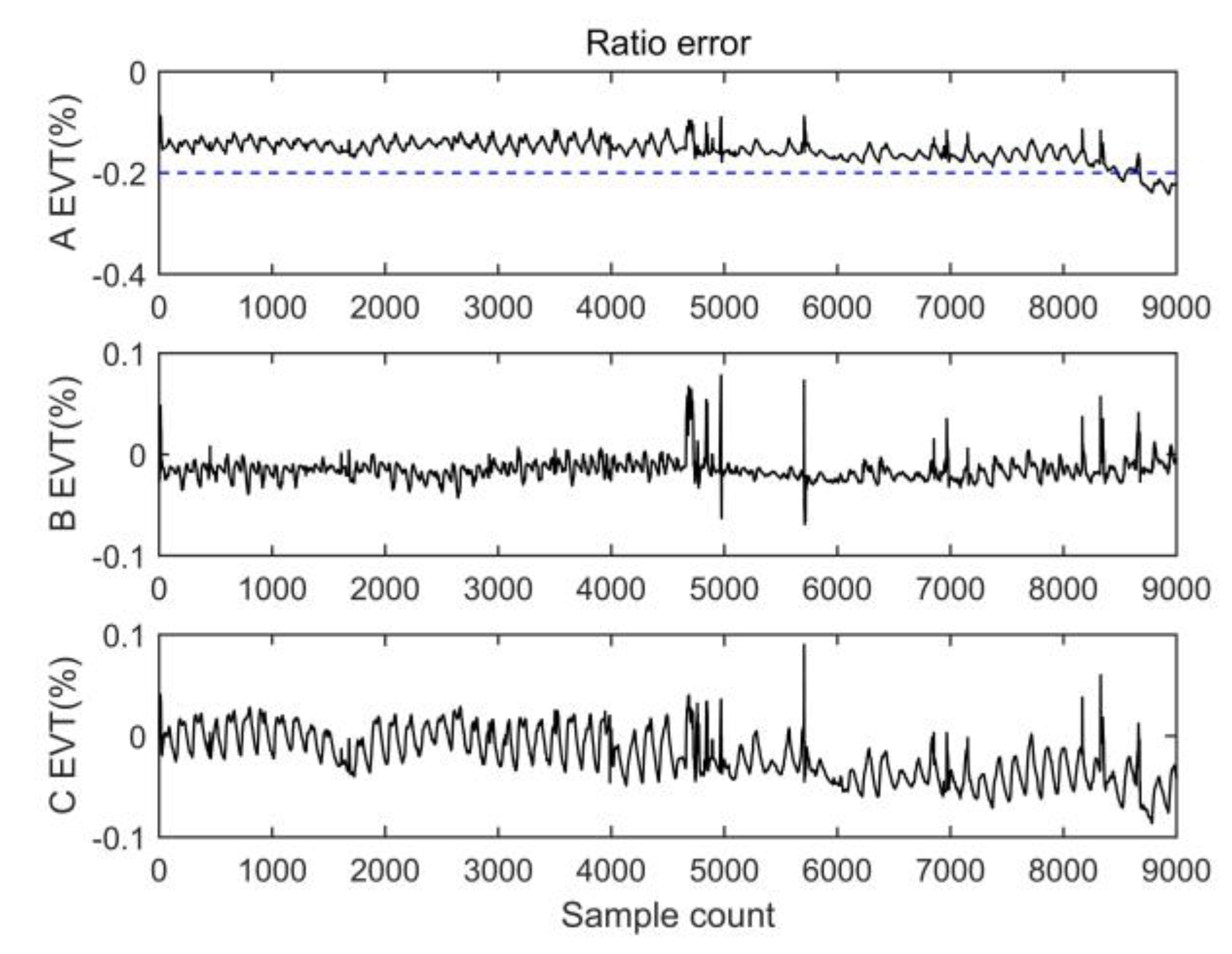

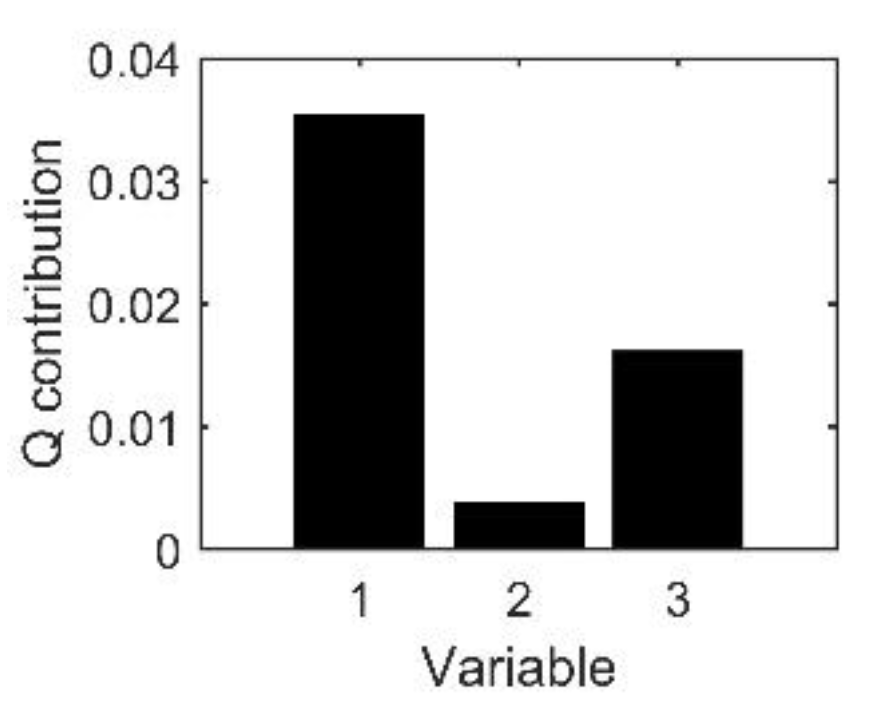

| Symbol | Parameter | Symbol | Parameter |
|---|---|---|---|
| vector of mean | covariance matrix | ||
| standard deviation matrix | eigenvalue matrix | ||
| standard data matrix | load matrix |
Publisher’s Note: MDPI stays neutral with regard to jurisdictional claims in published maps and institutional affiliations. |
© 2020 by the authors. Licensee MDPI, Basel, Switzerland. This article is an open access article distributed under the terms and conditions of the Creative Commons Attribution (CC BY) license (http://creativecommons.org/licenses/by/4.0/).
Share and Cite
Li, Z.; Zheng, Y.; Abu-Siada, A.; Lu, M.; Li, H.; Xu, Y. Online Evaluation for the Accuracy of Electronic Voltage Transformer Based on Recursive Principal Components Analysis. Energies 2020, 13, 5576. https://doi.org/10.3390/en13215576
Li Z, Zheng Y, Abu-Siada A, Lu M, Li H, Xu Y. Online Evaluation for the Accuracy of Electronic Voltage Transformer Based on Recursive Principal Components Analysis. Energies. 2020; 13(21):5576. https://doi.org/10.3390/en13215576
Chicago/Turabian StyleLi, Zhenhua, Yangang Zheng, Ahmed Abu-Siada, Mengyao Lu, Hongbin Li, and Yanchun Xu. 2020. "Online Evaluation for the Accuracy of Electronic Voltage Transformer Based on Recursive Principal Components Analysis" Energies 13, no. 21: 5576. https://doi.org/10.3390/en13215576
APA StyleLi, Z., Zheng, Y., Abu-Siada, A., Lu, M., Li, H., & Xu, Y. (2020). Online Evaluation for the Accuracy of Electronic Voltage Transformer Based on Recursive Principal Components Analysis. Energies, 13(21), 5576. https://doi.org/10.3390/en13215576






